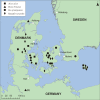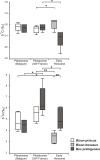European bison as a refugee species? Evidence from isotopic data on Early Holocene bison and other large herbivores in northern Europe
- PMID: 25671634
- PMCID: PMC4324907
- DOI: 10.1371/journal.pone.0115090
European bison as a refugee species? Evidence from isotopic data on Early Holocene bison and other large herbivores in northern Europe
Abstract
According to the refugee species concept, increasing replacement of open steppe by forest cover after the last glacial period and human pressure had together forced European bison (Bison bonasus)--the largest extant terrestrial mammal of Europe--into forests as a refuge habitat. The consequent decreased fitness and population density led to the gradual extinction of the species. Understanding the pre-refugee ecology of the species may help its conservation management and ensure its long time survival. In view of this, we investigated the abundance of stable isotopes (δ13C and δ15N) in radiocarbon dated skeletal remains of European bison and other large herbivores--aurochs (Bos primigenius), moose (Alces alces), and reindeer (Rangifer tarandus)--from the Early Holocene of northern Europe to reconstruct their dietary habits and pattern of habitat use in conditions of low human influence. Carbon and nitrogen isotopic compositions in collagen of the ungulate species in northern central Europe during the Early Holocene showed significant differences in the habitat use and the diet of these herbivores. The values of the δ13C and δ15N isotopes reflected the use of open habitats by bison, with their diet intermediate between that of aurochs (grazer) and of moose (browser). Our results show that, despite the partial overlap in carbon and nitrogen isotopic values of some species, Early Holocene large ungulates avoided competition by selection of different habitats or different food sources within similar environments. Although Early Holocene bison and Late Pleistocene steppe bison utilized open habitats, their diets were significantly different, as reflected by their δ15N values. Additional isotopic analyses show that modern populations of European bison utilize much more forested habitats than Early Holocene bison, which supports the refugee status of the species.
Conflict of interest statement
Figures





References
-
- Stuart AJ (1991) Mammalian extinctions in the Late Pleistocene of northern Eurasia and North America. Biological Review of the Cambridge Philosophical Society 66: 453–562. - PubMed
-
- Stuart AJ (1999) Late Pleistocene megafaunal extinctions: a European perspective. In: Extinctions in Near Time: Causes, Contexts, and Consequences (ed. MacPhee R. D. E.). New York: Kluwer Academic/Plenum; pp. 257–269.
-
- Turvey ST (2009) In the shadow of the magafauna: prehistoric mammal and bird extinctions across the Holocene. In: Turvey ST, editor. Holocene Extinctions. Oxford University Press, Oxford: pp. 17–39.
-
- Aaris-Sørensen K, Mühldorff R, Petersen EB (2007) The Scandinavian reindeer (Rangifer tarandus L.) after the last glacial maximum: time, seasonality and human exploitation. Journal of Archaeological Science 34: 914–923.
-
- Benecke N (2005) The Holocene distribution of European bison–the archaeozoological record. Munibe (Antropologia-Arkeologia) 57: 421–428.
Publication types
MeSH terms
Substances
LinkOut - more resources
Full Text Sources
Other Literature Sources

